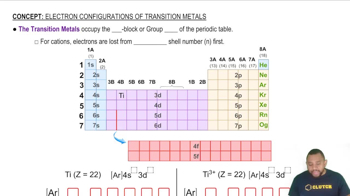Here are the essential concepts you must grasp in order to answer the question correctly.
Electron Configuration
Electron configuration describes the distribution of electrons in an atom's orbitals. It follows the Aufbau principle, which states that electrons fill lower-energy orbitals first, and is represented using a notation that indicates the energy levels and sublevels occupied by electrons. Understanding electron configuration is crucial for predicting the chemical behavior and properties of elements, especially transition metals.
Recommended video:
Electron Configuration Example
Transition Metals
Transition metals are elements found in the d-block of the periodic table, characterized by their ability to form variable oxidation states and complex ions. They typically have partially filled d orbitals, which play a significant role in their chemical reactivity and bonding. Transition metals often exhibit unique properties such as colored compounds and catalytic activity, making their electron configurations particularly important in understanding their behavior in compounds.
Recommended video:
Ionic Compounds and Oxidation States
Ionic compounds are formed when metals transfer electrons to nonmetals, resulting in the formation of cations and anions. The oxidation state of an element in a compound indicates the charge it would have if the compound were composed of ions. For transition metals, determining the oxidation state is essential for correctly writing the electron configuration of their ions, as it affects the number of electrons removed from the neutral atom.
Recommended video:




